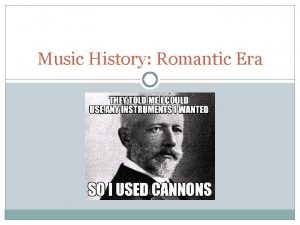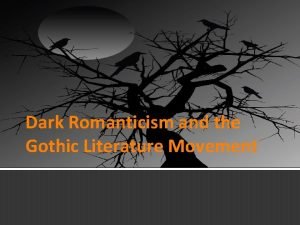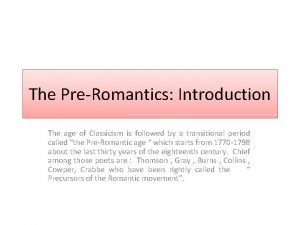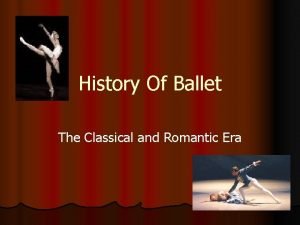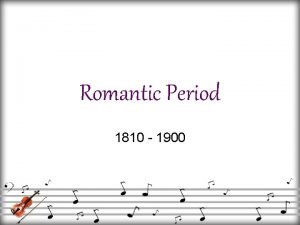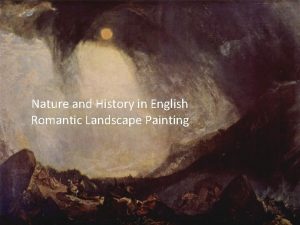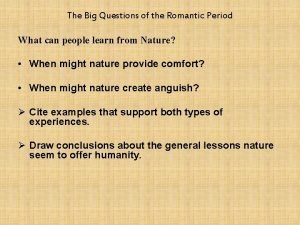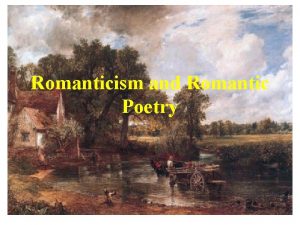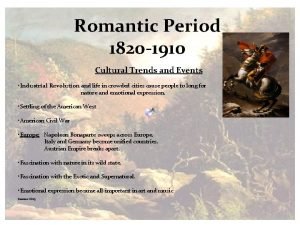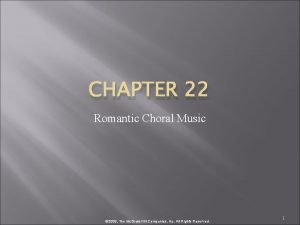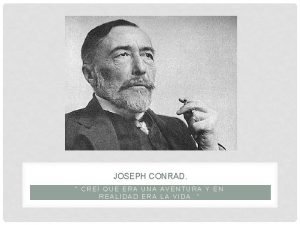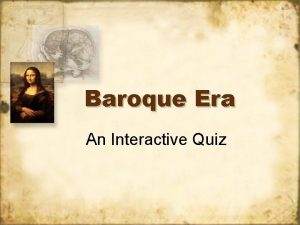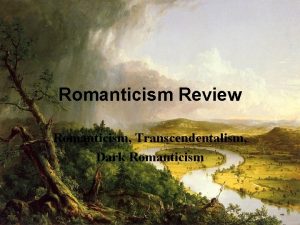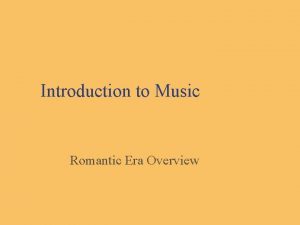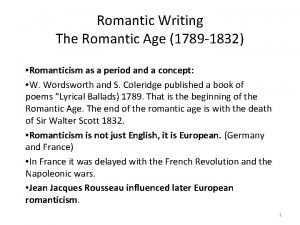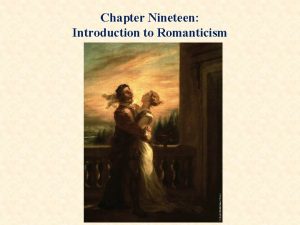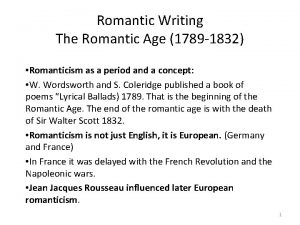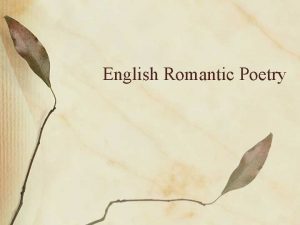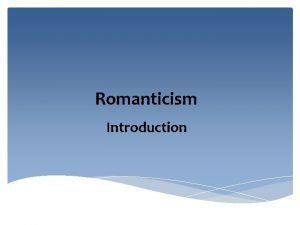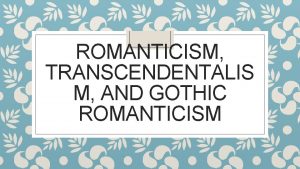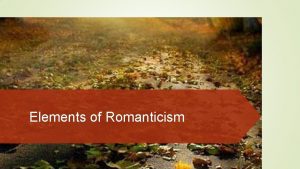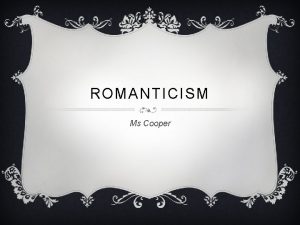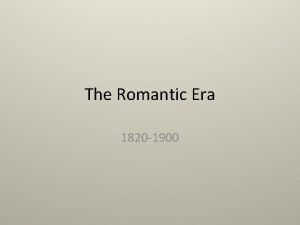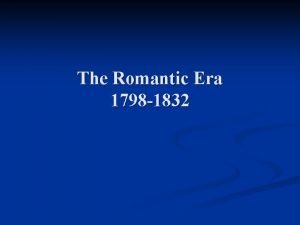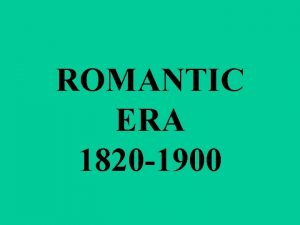Music of the Romantic Era Aspects of Romanticism

































- Slides: 33

Music of the Romantic Era

Aspects of Romanticism in music & art • Nature (idyllic or awesome, sublime) “organic unity” (music) • Supernatural, demonic • exoticism • “ancient” (Medieval (not Greek)) - rejection of Classicism & Renaissance • folklore and Das Volk (Nationalism)

Aspects of Romanticism in music & art • THE ARTIST APART FROM SOCIETY • THE ARTIST AS SOCIAL CRITIC/REVOLUTIONARY Beethoven’s 9 th Symphony • THE ARTIST AS GENIUS/CULTURAL HERO BEETHOVEN: “Why bow to social status? ”

The misunderstood genius “To be a genius is to be misunderstood” – Emerson The artist out in front, ahead of the audience, the advanced guard (a military metaphor) – the avant garde “Music could quickly come to such a point, that everyone who is not precisely familiar with the rules and difficulties of the art would find absolutely no enjoyment in it. ” A critic reviewing the premiere of Beethoven’s 3 rd Symphony

Early Beethoven He speaks Classical – the language of Mozart & Haydn

Beethoven Model Romantic genius-type Not a servant – an independent creator! Concerts very long – a new audience; amateurs left behind Music’s Trinity: Bach, Mozart, Beethoven

Beethoven 9 symphonies 16 string quartets 32 piano sonatas 5 piano concertos 1 violin concerto 1 opera

Beethoven LISTENING EXAMPLE Symphony No. 5 in C minor, 1 st mvt. Dramatic, even violent, but still in a perfectly structured sonata form All 4 movements unified by famous short-short-long motif Textbook CD example 1808

Beethoven LISTENING EXAMPLE Symphony No. 6 “The Pastoral” 5 movements, each with a descriptive title Pastoral with a sublime storm 1808

Goya, Executions of the Third of May, 1808 BEETHOVEN Symphonies 5 & 6 text p. 340

Schubert Only 31 years old at his death wrote 16 operas, only 3 performed in his lifetime; none performed today between 500 -600 songs a rather unstructured life Odd Textbook CD example

Schubert, Erlkonig 1815 (Goethe) (Narrator) Wer reitet so spät durch Nacht und Wind? Es ist der Vater mit seinem Kind; Er hat den Knaben wohl in dem Arm, Er fasst ihn sicher, er hält ihn warm. (Narrator) Who rides so late through the night and wind? It is a father with his child; he has the boy close in his arm, he holds him tight, he keeps him warm. (Father) "Mein Sohn, was birgst du so bang dein Gesicht? " (Father) "My son, why do you hide your face in fear? " (Son) "Siehst, Vater, du den Erlkönig nicht? Den Erlkönig mit Kron' und Schweif? " (Son) "Father, don't you see the Erlking? The Erlking with his crown and train? " (Father) "Mein Sohn, es ist ein Nebelstreif. " (Erlking) "Du liebes Kind, komm geh mit mir! Gar schöne Spiele spiel' ich mit dir; Manch' bunte Blumen sind an dem Strand; Meine Mutter hat manch' gülden Gewand. " (Father) "My son, it is a streak of mist. " (Erlking) "You dear child, come with me! I'll play very lovely games with you. There are lots of colourful flowers by the shore; my mother has some golden robes. "

(Son) "Mein Vater, mein Vater, und hörest du nicht, Was Erlkönig mir leise verspricht? " (Father) "Sei ruhig, bleibe ruhig, mein Kind; In dürren Blättern säuselt der Wind. " (Erlking) "Willst, feiner Knabe, du mit mir geh'n? Meine Töchter sollen dich warten schön; Meine Töchter führen den nächtlichen Reih'n Und wiegen und tanzen und singen dich ein. " (Son) "Mein Vater, mein Vater, und siehst du nicht dort, Erlkönigs Töchter am düsteren Ort? " (Son) "My father, my father, don't you hear the Erking whispering promises to me? " (Father) "Be still, stay calm, my child; it's the wind rustling in the dry leaves. " (Erlking) "My find lad, do you want to come with me? My daughters will take care of you; my daughters lead the nightly dance, and they'll rock and dance and sing you to sleep. " (Son) "My father, my father, don't you see the Erlking's daughters over there in the shadows? "

(Father) "Mein Sohn, mein Sohn, ich seh' es genau, Es scheinen die alten Weiden so grau. " (Erlking) "Ich liebe dich, mich reizt deine schöne Gestalt, Und bist du nicht willig, so brauch ich Gewalt. " (Son) "Mein Vater, mein Vater, jetzt fasst er mich an! Erlkönig hat mir ein Leids getan!" (Narrator) Dem Vater grauset's, er reitet geschwind, Er hält in Armen das ächzende Kind, Erreicht den Hof mit Müh und Noth; (Father) "My son, my son, I see it clearly, it's the gray sheen of the old willows. " (Erlking) "I love you, your beautiful form delights me! And if you're not willing, then I'll use force. " (Son) "My father, my father, now he's grasping me! The Erlking has hurt me!" (Narrator) The father shudders, he rides swiftly, he holds the moaning child in his arms; with effort and urgency he reaches the courtyard:

In seinen Armen das Kind war tot. Emotions? in his arms the child was dead. Balance, repose, clarity? NO! FEAR & SUPERNATURAL EVIL Is death tempting & attractive?

Another development In the 1830 s, composer/conductor Felix Mendelssohn conducts a performance of Bach’s Mass in B minor – so what? MUSIC OF THE PAST BEGINS TO TAKE A PLACE ON CONCERT PROGRAMS – IT EVENTUALLY DOMINATES CONCERT PROGRAMMING By 1870, seventy-five per cent of works in the Gewandhaus (a famous German orchestra) repertory were by dead composers.

Berlioz Symphonie Fantastique - program music - themes of love, madness, drugs, death, demons Textbook CD example

Berlioz Symphonie Fantastique - idee fixe - themes not worked-out in the German way; emphasis on effects and color - 1831

I. Reveries – Passions A young musician, afflicted with "undirected emotionalism, " sees the woman of his dreams and falls hopelessly in love. . . II. A Ball III. Scene in the Country IV. March to the Scaffold. Convinced that his love is unrequited, the artist takes an overdose of opium. It plunges him into a sleep accompanied by horrifying visions. He dreams that he has killed his beloved, has been condemned and led to the scaffold, and is witnessing his own execution. The procession advances to a march that is now somber and savage, now brilliant and solemn. At its conclusion the idee fixe returns, like a final thought of the beloved, cut off by the fatal blow. Textbook CD example

(Dies irae – traditional text and chant melody, part of the requiem mass for the dead) V. Dream of a Witches' Sabbath He sees himself in the midst of a frightful throng of ghosts, witches, monsters of every kind, who have assembled for his funeral. Strange noises, groans, bursts of laughter, distant cries. The beloved melody again reappears, but it has lost its modesty and nobility; it is no more than a vulgar dance tune, trivial and grotesque; it is she, coming to the Sabbath. A joyous roar greets her arrival. . She joins in the devilish orgy. . A funeral knell, a parody of the Dies irae. A Sabbath round-dance. The Dies irae and the round-dance are combined.

Goya, Witches’ Sabbath, c. 1819 -23

Chopin Famous pianist, but gave only 14 public performances in his 39 -year life!

Frédéric Chopin Nocturne in F minor, Opus 55, No. 1 -- introspective mood; psychologically probing? -- as if "spontaneous" or improvised (in fact neatly structured) -- a distant view of folk music (note the veiled suggestion of dance music), which relates to the Romantic interest in ethnicity and Nationalism -- expanding use of chromatic harmony -- use of dissonance for color

Goya, The Sleep of Reason Brings Forth Monsters 1796 -8 etching

Richard Wagner OPERA INNOVATOR The Ring – over 18 hours of music

Tristan und Isolde 1865 A little break from The Ring Previously tries to integrate all arts into single theatrical experience; changes his mind – Music reigns supreme

Tristan und Isolde Wagner - wrote the words - wrote the music - designed the sets - designed the costumes - directed the stage action “Gesamkunstler” “total artist”

Designed and built theater at Bayreuth 1957 production of Parsifal see p. 361

Tristan und Isolde (1865) -- expanding use of chromatic harmony over long spans of time -- opera expands in size: larger orchestra, longer operas (The Ring takes four evenings to perform) -- sophisticated orchestration -- opera is now continuous: the aria/recitative concept is replaced by "continuous melody" -- Wagner develops the idea of "leitmotif, " in which a brief musical idea is associated with a character, idea, or object in an opera

Tristan und Isolde – how Romantic? • Medieval tale of chivalry • exotic (Ireland & Cornwall) • magic potion & sorceress • emotionally fluid, passionate • psychologically probing • unified through leitmotifs Love, Death – transcendence - ECHT!

“Folk” NATIONALISM Verdi and V. E. R. D. I Composer as national/popular figure LISTENING EXAMPLE FROM Rigoletto “La Donna Mobilé”

Aspects of Romanticism in music & art • THE ARTIST APART FROM SOCIETY • THE ARTIST AS SOCIAL CRITIC/REVOLUTIONARY Beethoven’s 9 th Symphony • THE ARTIST AS GENIUS/CULTURAL HERO BEETHOVEN: “Why bow to social status? ”

Aspects of Romanticism in music & art • Nature (idyllic or awesome, sublime) “organic unity” (music) BEETHOVEN SYMPHONY No. 5 • Supernatural – Berlioz, WAGNER TRISTAN • dream world, interior world CHOPIN NOCTURNE • exoticism – Beethoven Symphony No. 9 • “ancient” (Medieval) old – Bach WAGNER TRISTAN • folklore and Das Volk (Nationalism) WAGNER The Ring
 Composers expressed nationalism in their music by
Composers expressed nationalism in their music by Romantic era art song drawing
Romantic era art song drawing Online music portfolio
Online music portfolio Features of romanticism
Features of romanticism English romanticism characteristics
English romanticism characteristics The romanticism (1795 — 1835) what is romanticism
The romanticism (1795 — 1835) what is romanticism Romanticism and dark romanticism
Romanticism and dark romanticism Pre romantic poetry characteristics
Pre romantic poetry characteristics Romantic era poetry characteristics
Romantic era poetry characteristics Romantic ballet characteristics
Romantic ballet characteristics Romantic movement in american literature
Romantic movement in american literature Characteristic of the romantic period
Characteristic of the romantic period Romantic era landscape painting
Romantic era landscape painting Wagner romantic period
Wagner romantic period Characteristics of romantic era theater
Characteristics of romantic era theater Questions about romanticism
Questions about romanticism Characteristics of romantic era poetry
Characteristics of romantic era poetry Romantic era dance
Romantic era dance Music of the romantic period
Music of the romantic period Vocal music of the romantic period
Vocal music of the romantic period Romantic period choral music
Romantic period choral music Victorian and elizabethan era
Victorian and elizabethan era Creí que era una aventura y en realidad era la vida
Creí que era una aventura y en realidad era la vida Era uma estrela tão alta era uma estrela tão fria
Era uma estrela tão alta era uma estrela tão fria Era quiz: the baroque era
Era quiz: the baroque era Music timeline
Music timeline Musical periods
Musical periods Modern era music
Modern era music Music that employs electronic music
Music that employs electronic music Ilocos folk songs
Ilocos folk songs Music appreciation elements of music
Music appreciation elements of music Frameset trong html5
Frameset trong html5 Sơ đồ cơ thể người
Sơ đồ cơ thể người Số nguyên tố là gì
Số nguyên tố là gì
